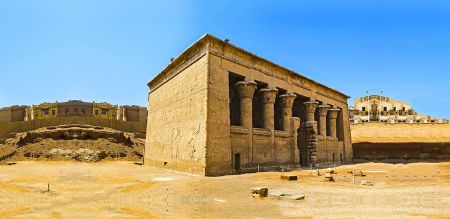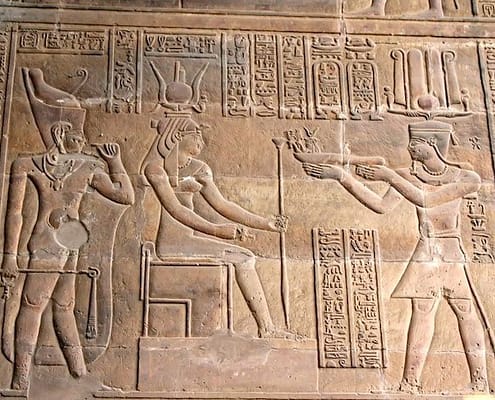The Temple of Khnum: A Must-Visit for Egypt Travellers

I. The Significance of the Temple of Khnum in Egyptian History
The Temple of Khnum is a remarkable ancient structure in Esna, Egypt. It is dedicated to the worship of Khnum, the ancient Egyptian god of the Nile and creation. This temple is a must-visit for travellers interested in Egyptian history and culture.
The Temple of Khnum holds significant historical and religious importance in Egyptian history. It was built during the Ptolemaic period, between the 3rd century BC and the 1st century AD. The temple was constructed on the site of an earlier temple, indicating the longevity of its religious significance.
In ancient Egyptian mythology, Khnum was believed to be the creator and moulder of all living beings on his potter's wheel. He was often depicted as a man with the head of a ram, symbolizing his role as the creator of the Nile's flooding and fertility. The Temple of Khnum was a centre for worship and offerings to this important deity.
The temple also played a role in the annual Opet Festival, a religious celebration dedicated to rejuvenating the kingship and the fertility of the land. During this festival, the statues of the gods were transported in a magnificent procession from the Temple of Luxor to the Temple of Khnum in Esna.
Why You Should Visit the Temple of Khnum
Visiting the Temple of Khnum offers a unique opportunity to explore ancient Egypt's rich history and architectural wonders. Here are some reasons why you should include this temple in your travel itinerary:
1. Stunning Architecture: The Temple of Khnum showcases impressive architectural elements, including intricately carved columns, wall reliefs, and a beautiful hypostyle hall. The temple's well-preserved facade is particularly notable, adorned with detailed reliefs depicting Egyptian gods and pharaohs.
2. Historical and Cultural Significance: Exploring the Temple of Khnum provides a fascinating glimpse into the ancient Egyptian civilization and its religious practices. The temple's inscriptions and reliefs offer insights into the worship of Khnum and the myths and rituals associated with this deity.
3. Lesser-Known Tourist Destination: Compared to other well-known ancient Egyptian sites like the Pyramids of Giza or the temples of Luxor, the Temple of Khnum attracts fewer tourists. This means you can explore the temple at your own pace and fully immerse yourself in its tranquil and mystical atmosphere.
4. Local Experience: Esna, where the Temple of Khnum is located, provides an authentic Egyptian experience away from the crowds. You can interact with friendly locals, explore the bustling local market, and discover a traditional Egyptian town's charm and daily life.
Visiting the Temple of Khnum is a chance to step back in time and witness the grandeur of ancient Egypt. Whether you are a history enthusiast, a cultural explorer, or someone seeking a unique travel experience, this temple offers a remarkable journey into the heart of ancient Egyptian civilization.

II. History and Architecture of the Temple of Khnum
The Origins and Construction of the Temple
The Temple of Khnum, located in the ancient city of Esna, Egypt, is a must-visit destination for travellers interested in Egyptian history and architecture. The temple is dedicated to Khnum, the ram-headed god of creation, and it dates back to the Ptolemaic period of ancient Egypt.
Construction: The Temple of Khnum was constructed over several centuries, with different rulers adding their additions and modifications. The temple was initially built during the reign of Ptolemy VI Philometor in the 3rd century BCE, and it was expanded and renovated by subsequent Ptolemaic and Roman rulers. The temple's construction is a testament to the architectural achievements of ancient Egypt, showcasing intricate carvings and detailed reliefs.
Importance: The Temple of Khnum played a significant role in ancient Egypt's religious and cultural life. It was a centre of worship for Khnum, who was believed to be the creator of all things and the shaper of the Nile River. The temple was also home to various festivals and ceremonies dedicated to Khnum and other deities.
The Architectural Features of the Temple
The Temple of Khnum is known for its impressive architectural features, which highlight the artistic and engineering prowess of the ancient Egyptians. Some notable features of the temple include:
Hypostyle Hall: One of the main highlights of the temple is its hypostyle hall, which is a large hall supported by rows of massive columns. The hall is adorned with intricate carvings and reliefs depicting scenes from ancient Egyptian mythology and daily life.
Ceilings and Walls: The temple's ceilings and walls are adorned with colourful paintings and hieroglyphic inscriptions. These intricate decorations provide valuable insights into ancient Egyptian beliefs, rituals, and history.
Facade and Entrance: The temple features a grand entrance gate decorated with carvings of gods, pharaohs, and various symbols. The entrance gate opens into a courtyard leading to the main temple complex.
Sanctuary: The innermost section of the temple is the sanctuary, where the cult statues of Khnum and other deities were housed. The sanctuary provided a sacred space for religious rituals and offerings.
Visiting the Temple of Khnum offers a unique opportunity to admire the architectural marvels of ancient Egypt and immerse oneself in the rich history and mythology of the region. The intricate carvings, vibrant paintings, and sacred atmosphere make the temple a must-see attraction for Egypt travellers.
Remember to plan your visit accordingly and check for any restrictions or guidelines before travelling to ensure a smooth and enjoyable experience. Exploring the Temple of Khnum will undoubtedly leave you in awe of the ancient Egyptian civilization and its architectural achievements.

III. The Main Attractions of the Temple of Khnum
When visiting Egypt, the Temple of Khnum is a must-visit destination for travellers interested in ancient Egyptian history and architecture. Located in Esna, this temple is dedicated to Khnum, the god of the Nile and creator of human bodies according to ancient Egyptian mythology. This well-preserved temple offers a glimpse into the rich cultural heritage of Egypt, with many fascinating attractions to explore.
Exploring the Hypostyle Hall and its Intricate Columns
One of the main highlights of the Temple of Khnum is the Hypostyle Hall, a spacious chamber supported by a forest of intricately carved columns. As you enter the hall, you will be greeted by the magnificent sight of towering columns adorned with elaborate hieroglyphics and detailed reliefs. The columns are adorned with floral motifs, scenes of pharaohs, and various deities, giving visitors a glimpse into the ancient Egyptian pantheon.
Some key features of the Hypostyle Hall include:
- Size: The hall measures approximately 18 meters long and 15.5 meters wide, making it a grand space that inspires awe in visitors.
- Columns: The hall contains 24 columns, each standing at a height of around 6 meters. These columns are intricately carved and decorated, showcasing the ancient Egyptians' mastery in architectural design.
- Reliefs: The walls of the Hypostyle Hall are adorned with detailed relief carvings depicting various religious and mythological scenes. These reliefs provide valuable insights into the beliefs and rituals of ancient Egyptian society.
Exploring the Hypostyle Hall is a fascinating experience that immerses you in the ancient world. Take your time to admire the intricate details of the columns and study the reliefs to understand Egyptian culture better.
Admiring the Detailed Relief Carvings on the Temple Walls
Another highlight of the Temple of Khnum is the detailed relief carvings on the temple walls. These carvings depict a wide range of subjects, including religious rituals, sacred animals, and scenes from Egyptian mythology. The relief carvings are incredibly well-preserved and provide valuable insights into the daily life and beliefs of ancient Egyptians.
Some notable relief carvings to look out for include:
- Processions and Offerings: Many relief carvings depict processions of pharaohs, priests, and worshippers bringing offerings to the gods. These scenes offer a glimpse into ancient Egyptian society's religious practices and rituals.
- Divine Figures: The carvings also feature various gods and goddesses, such as Khnum, Hathor, and Horus. These deities are often depicted powerfully and majestically, reflecting their significance in ancient Egyptian religion.
- Mythological Scenes: Some relief carvings portray scenes from Egyptian mythology, such as the world's creation or the pharaoh's triumphs. These scenes provide insights into the ancient Egyptians' belief system and world understanding.
Admiring the detailed relief carvings is an immersive experience that brings ancient Egyptian culture to life. Take the time to study each carving and appreciate the skill and artistry that went into creating these stunning works.
Visiting the Temple of Khnum is a journey through time, offering a unique opportunity to explore ancient Egypt's rich history and architectural wonders. From the grand Hypostyle Hall to the intricate relief carvings, every corner of this temple holds treasures waiting to be discovered. So, if you're planning a trip to Egypt, include the Temple of Khnum on your itinerary for an unforgettable experience.

IV. The Importance of Khnum in Ancient Egyptian Religion
Understanding the Role of Khnum in Egyptian Mythology
In ancient Egyptian mythology, Khnum was considered the god of creation, responsible for moulding the bodies of both humans and gods. He was believed to be the divine potter who shaped each person's destiny on his potter's wheel. Khnum was often depicted with a ram's head, symbolizing his connection to fertility and abundance. His role in the pantheon of Egyptian gods was crucial, as he was seen as the creator of life itself.
Learning about the worship and rituals at the Temple
The Temple of Khnum, located in the city of Esna, is one of Egypt's most significant religious sites. It was dedicated to the worship of Khnum and served as a centre for religious ceremonies and rituals. The temple's construction began during the reign of Ptolemy VI Philometor in the 3rd century BC and was completed during the Roman period.
Visitors to the Temple of Khnum can delve into the ancient practices and rituals associated with worshipping this important god. The temple's architecture and inscriptions provide valuable insights into ancient Egyptians' religious beliefs and daily life.
Offerings: Worshippers would bring offerings such as food, flowers, or incense to the temple as a sign of devotion and gratitude to Khnum. These offerings were believed to please god and ensure his blessings upon the individuals and the community.
Prayers and Invocations: Priests and worshippers would recite prayers and invocations to Khnum, seeking his guidance, protection, and favour. These rituals were accompanied by music and chanting, creating a sacred and reverent atmosphere within the temple.
Festivals: The Temple of Khnum was also the site of various religious festivals commemorating the god and celebrating his role in creation. These festivals included processions, dances, and performances showcasing ancient Egypt's rich cultural heritage.
Visiting the Temple of Khnum today provides a unique opportunity to immerse oneself in ancient Egyptian religious practices and gain a deeper understanding of the worship of Khnum. The temple's well-preserved reliefs, columns, and hieroglyphics offer a glimpse into the rituals and beliefs that shaped the lives of the ancient Egyptians.
To learn more about ancient Egyptian mythology and the worship of Khnum, you can visit this external website that provides detailed information on the god and his significance in Egyptian culture.
The Temple of Khnum is a testament to ancient Egypt's rich religious and cultural heritage. Its historical significance, architectural beauty, and spiritual atmosphere make it a must-visit for travellers interested in exploring the fascinating world of ancient Egyptian mythology and religion.

V. Practical Information for Visitors
Visiting Hours and Ticket Information
The Temple of Khnum is a must-visit destination for travellers interested in ancient Egyptian history and architecture. Before planning your visit, it's essential to know the visiting hours and ticket information to make the most of your experience.
- The temple is open to visitors from 9:00 AM to 5:00 PM daily.
- Tickets can be purchased on-site at the entrance of the temple.
- The ticket price for adults is $10, and children under 12 can enter for free.
It's always a good idea to check the opening hours and ticket prices in advance, as they may be subject to change. You can find updated information on the official website of the Egyptian Ministry of Tourism.
Tips for Making the Most of Your Visit to the Temple of Khnum
To ensure a memorable and enjoyable visit to the Temple of Khnum, consider the following tips:
-
Plan your visit: Spend some time researching the history and significance of the temple before your visit. This will enhance your appreciation for the site and allow you to understand the intricate carvings and artworks better.
-
Wear comfortable clothing and shoes: The temple complex is expansive and involves much walking. Wear comfortable clothing and footwear to ensure a pleasant experience.
-
Bring water and snacks: Exploring the temple complex can be physically demanding, especially during the hot summer. Stay hydrated with a water bottle, and pack some healthy snacks to keep your energy levels up.
-
Respect the rules and regulations: The Temple of Khnum is a sacred site, and visitors must follow certain rules and regulations. Remember signs and instructions, and avoid touching or damaging ancient structures or artefacts.
-
Take your time: The Temple of Khnum is a place of profound historical and cultural significance. Take your time to explore the intricacies of the temple and its surroundings. Allow yourself to be captivated by the majestic columns, detailed carvings, and beautiful hieroglyphics.
-
Engage with a guide: Consider hiring a local guide who can provide in-depth knowledge and insights about the temple. A knowledgeable guide can enhance your understanding and appreciation of the site.
-
Capture memories: The Temple of Khnum offers breathtaking photo opportunities. Capture the beauty of the temple and its surroundings, but remember to be respectful of other visitors and the sacred nature of the site.
Visiting the Temple of Khnum is a captivating journey through ancient Egyptian history. By following these tips, you can make the most of your visit and create lasting memories of this remarkable site.
